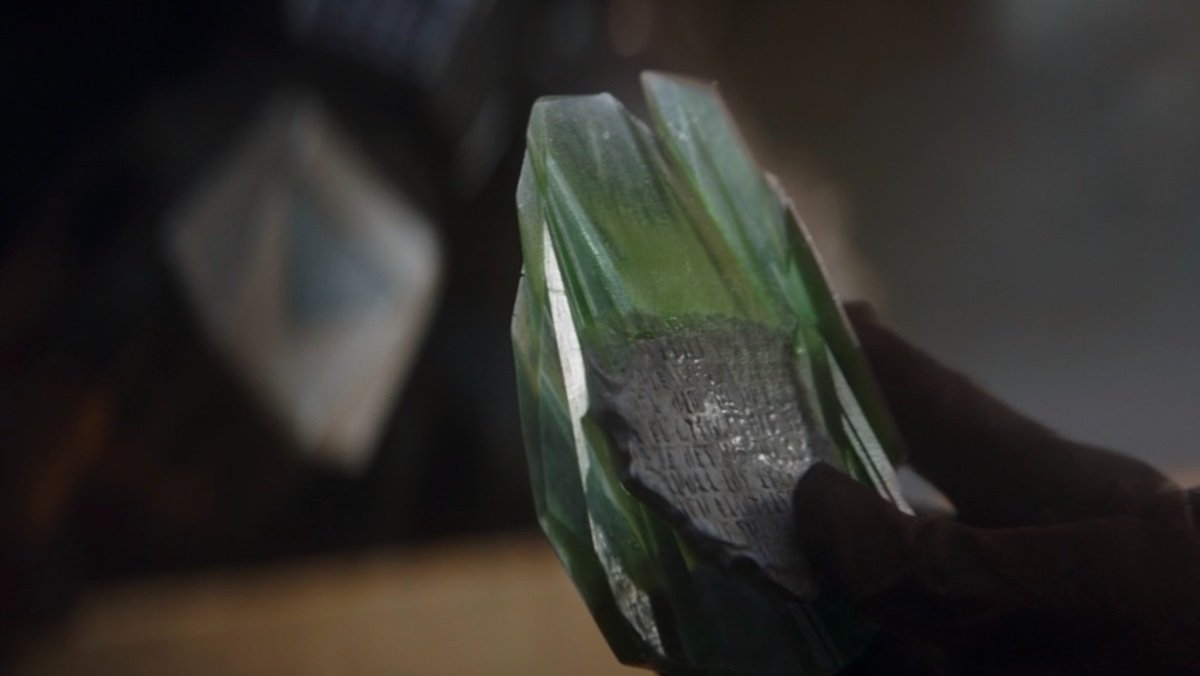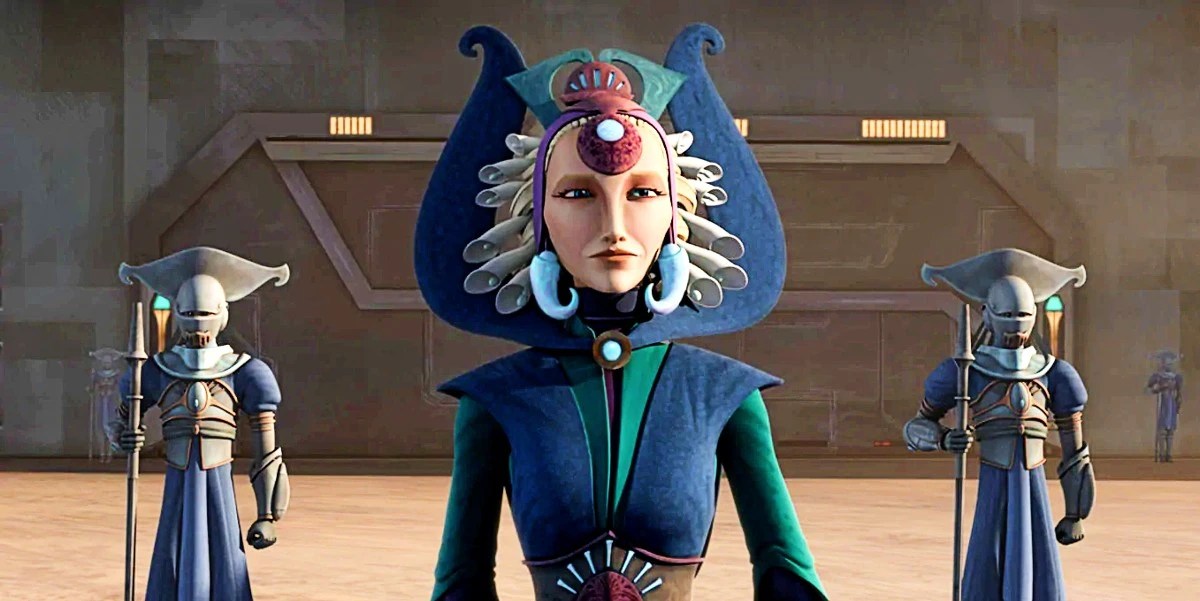Passover ended at sundown this past Thursday, April 13, and I’ll be honest, it’s SO nice to be eating leavened bread again. But as I was eating buttered matzah for breakfast Wednesday while watching this week’s episode of The Mandalorian, this line from Din to Bo-Katan about a destroyed Mandalore stuck out to me:
“We’ll rebuild it. Isn’t that our history? For thousands of years we have been on the verge of extinction, and for thousands of years we have survived.”
Having come to the end of yet another Passover where Jews promise to see each other “next year in Jerusalem” after re-telling the story of our deliverance from slavery, this line hit different. And I’m certainly not the only one who sees the Jewishness in Mandalorians.
**LIGHT SPOILERS ahead for The Mandalorian, Season Three**
Jewish cultural signifiers in The Mandalorian
A while back, I came across this awesome video from TikTok user Morgana (@inmorganic) about the many things in The Mandalorian, particularly in the current season, that just scream “Jewish”:
- the “Living Waters” in which Mandalorians must submerge themselves in order to be redeemed: similar to the Jewish mikvah, in which Jews submerge themselves for various reasons, including purification, to mark significant life events, etc.
- the Mandalorian covert: she likens their community to a shtetl, or a small, Jewish Eastern European town
- the Mandalorian helmet ceremony: a coming-of-age ritual for 12–13-year-olds similar to Jewish children becoming b’nai mitzvah (b’nai is gender-neutral. “Bar” for boys, “bat” for girls)
- the mythosaur: similar to a Leviathan. In Hebrew, the word is Livyatan, which comes from a root that means “twist, turn, wind, or coil.” The Leviathan is a primeval sea monster mentioned in the Tanakh (Psalms 74:14, and other places) that God killed for the Jews to eat when they were wandering in the wilderness in Exodus.
- destruction of the Forge: similar to the destruction of the Second Temple in Jerusalem, which was destroyed by the Romans after having stood for over 500 years. Now, parts of the Kotel (AKA the “Western Wall”) are all that remain.
- Mandalorian helmets: similar to kippot (sin. kippa), which are worn by Orthodox Jews all the time, but only for certain occasions by less traditional Jews.
Pop Culture Rabbi (@popculturerabbi) also posted this video on TikTok about Jewish law and “The Way:”
The name for all of Jewish law, halakha in Hebrew, literally means “The Way.” And as Pop Culture Rabbi points out in his video, different Jews have different relationships to halakha. Orthodox Jews (much like The Tribe on The Mandalorian … I mean, it’s called The Tribe, for crying out loud!) follow The Way strictly, while Conservative, Reform, and Reconstructionist Jews each have their own unique relationships to halakha and how much they allow it to inform their day-to-day lives.
Jewishness etched into Mandalore

And then there was the crystal Din brought to Bo-Katan to prove that he’d been on Mandalore’s surface. Trapped in the crystal is a fragment of stone with Mando’a words carved into it. Of course, the Internet is gonna Internet, and it was only a matter of time before someone was going to decode this text.
Self-proclaimed “sci-fi and linguistics geek,” GeneralAnubis, took to Reddit to reveal that the Mando’a text on the stone is actually a Biblical verse from Exodus! He even provides an image to show the Mando’a transliteration and how it falls on the fragment of stone, which is really cool.
The translation of the verse he gives is taken from the Christian “King James Bible.” Since I’m a Jew talking about the Jewishness of Mandalorians, I’ll provide two translations of Exodus Ch. 10, Verses 5-6 from Jewish sources to contrast and compare.
This is the part of Exodus where Moses is demanding that the Pharaoh free the Hebrew slaves, or God will unleash locusts:
“‘They shall cover the surface of the land, so that no one will be able to see the land. They shall devour the surviving remnant that was left to you after the hail; and they shall eat away all your trees that grow in the field. Moreover, they shall fill your palaces and the houses of all your courtiers and of all the Egyptians—something that neither your fathers nor fathers’ fathers have seen from the day they appeared on earth to this day.’ With that he turned and left Pharaoh’s presence.”
JPS Hebrew-English Tanakh, Second Edition
“‘They will cover the aspect of the ground, so that one will not be
The Five Books of Moses, Everett Fox
able to see the ground,
they will consume what is left of what escaped, of what remains
for you from the hail,
they will consume all the trees that spring up for you from the
field,
they will fill your houses, the houses of all your servants, and the
houses of all Egypt,
as neither your fathers nor your fathers’ fathers have seen
from the day of their being upon the soil until this day.’
He turned and went out from Pharaoh.”
I could probably write a whole other post about why this particular verse was found etched in stone on Mandalore. Was it a prophecy? Are the locusts symbolic of the Empire’s destruction, and was that a prophecy? Or is this verse prophesying a leader like Bo-Katan delivering a similar threat to Moff Gideon of swarming by a newly reunited Mandalorian people? Is Bo-Katan basically Moses?
What’s in a name?

And can we just talk about how Bo-Katan’s father is named Duke Adonai Kryze. Adonai means “The Lord” in Hebrew, and is what Jews call God in prayers.
Also, the name “Bo-Katan” is interesting, too. Bo is the command form of either “go” or “come” in Hebrew. Katan is Hebrew for “small.” So, Bo-Katan means either “go small” or “come small.” This is interesting, considering she’s the younger sister of Satine Kryze, who ruled Mandalore during the Clone Wars, and after whose death Bo-Katan became Regent of Mandalore for a minute before losing her position.
“Satine” is a French name meaning “smooth” or “shiny.” Clearly the first-born who was meant to rule was the sparkly, assimilated one who wanted to appease and remain uninvolved rather than fight the Empire, and didn’t get a Hebrew name.
Will Bo-Katan always “come small?” Is that her destiny? Did her father, Adonai, name her “go small,” because that’s all she was ever supposed to be? Or, was she named that ironically by Clone Wars writers, because she was actually destined for greater things? Is she meant to David and Golliath this sh*t?
Clearly, the connection between Mandalorian culture and Judaism goes further back than The Mandalorian.
Oh, and because I can’t help myself….the word Din in Hebrew means “judgement.” When I became Jewish years ago, I had to sit before a beit din, ie: a “house of judgement,” a Jewish court of three rabbinic judges, responsible for handling matters of religious law.
So, does Din Djarin exist to pass judgement on those who would threaten Mandalorians? Maybe.
Is all this on purpose?
The above feels like a lot to be mere coincidence. In a piece called “The Mandalorthodox” at The Jewish Standard, Larry Yudelson writes about the connections above as well. He goes on to talk about The Mandalorian‘s creator, Jon Favreau, whose mother was Jewish (his father was Catholic):
“But in 2019, the Star Wars universe got decidedly more Jewy, with the launch of Disney’s “The Mandalorian.” It was billed as a “space Western,” but the true hint of what was to come was buried in the credits: It was produced by Golem Creations, the company founded by the show’s producer and lead writer, Jon Favreau. Favreau may have indeed “dropped out of Hebrew school to pursue acting,” as per Wikipedia, but observers with far more extensive formal Jewish schooling keep noticing signs of Yiddishkeit.”
While I know that Favreau celebrated becoming bar mitzvah, I have no idea how Jewish Favreau considers himself these days. Still, it seems clear that regardless of how much Jewish culture feeds him personally, it certainly feeds him creatively.
His connection to Judaism, as well as that of Jewish writers from The Clone Wars onward, has allowed them to build out Mandalorian culture to be compelling, nuanced, and fascinating.
This is the halakha.
(featured image: Disney)









Published: Apr 14, 2023 05:30 pm